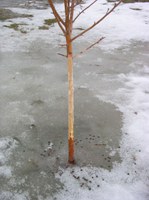Dakota Gardener: Midwinter Check-in
(Click an image below to view a high-resolution image that can be downloaded)
By Joe Zeleznik, Forester
NDSU Extension
It’s almost mid-February, so it’s time to check in.
How are you?
I hope you’re doing well. Winter is a tough time for a lot of people. Days are short and nights are long. It’s been awfully, awfully cold this year and that makes it tough to get outside. My neighbor and my wife both informed me last night that I haven’t been out ice fishing at all this year. I hadn’t even realized it.
Human health sometimes suffers in the winter. How about tree health?
At least in my own yard, it’s been a tough winter so far. The trees will mostly be able to handle the cold temperatures. However, the wildlife is making their presence known.
Squirrels can cause a lot of damage to twigs and smaller branches during the winter. They’ll strip the bark and eat the sugar-rich phloem underneath. This injury kills those branches and causes problems the following year. The squirrels in my yard are stripping a lot of the maple twigs. It doesn’t happen every year, but there were very few acorns on the oak trees last year and the squirrels had little food to cache. Right now, they’re looking for anything they can find to help them make it through the winter. Linden (basswood) trees are also a favorite target for squirrels.
The woodpeckers are causing some harm as well. I usually don’t blame the birds for tree damage, though. They’re simply foraging for insects which might be hiding in crevices or under the bark. When the birds dig deeper into the wood, they’re going after insects that are already damaging the tree. While the birds help get those insects out of the tree, it comes at a cost – a larger wound. Right now, there’s a lot of tree bark littering the yard.
On a positive note, I’ve been able to keep the rabbits at bay so far. Fingers crossed, my apple trees will make it through the winter without the rabbits chewing the bark. Like their squirrel cousins, they’re going after the sugar-rich phloem. I wrapped one apple tree in hardware cloth, which guarantees that the rabbits won’t chew its stem. However, we’ve had some pretty big snowdrifts this year and that would allow easy access to the branches, and to the part of the stem that’s above the height of the hardware cloth. I’ve had to knock those snowdrifts back a couple of times so far, right next to the stem.
For the larger apple tree, it’s a different story. I haven’t protected the stem. That stem hasn’t been attacked yet, but the suckers from the base of that tree have been eaten back. I should probably wrap the tree before something bad happens.
On another positive note, we haven’t had any problems with deer in our yard this winter. Last summer, though, a few came through and ate some of the lower branches of the apple tree. This winter, I’ve seen their tracks in the driveway, but the apple trees still are safe.
About a year ago, I noticed that the crown of one of our spruce trees was starting to thin out. Sure enough, it was infected with Stigmina needlecast. The needlecast diseases are tough to manage and I decided to let the disease run its course. The thin crown has gotten worse this winter as the high winds have knocked off a lot of the remaining needles of the spruce tree. Eventually, the tree will lose so many needles that it won’t survive.
It’s been a tough winter for the trees in my yard. How are your trees doing? Winter is a great time to check out the tree crowns and find those spots that may become problems next summer.
Despite all that winter throws at our trees, most of them are likely to survive and will even thrive next year. Just like us, the trees are tough.
NDSU Agriculture Communication – Feb. 8, 2022
Source: Joe Zeleznik, 701-231-8143, joseph.zeleznik@ndsu.edu
Editor: Kelli Anderson, 701-231-6136, kelli.c.anderson@ndsu.edu




